Predicting the Production and Depletion of Rare Earth Elements and Their Influence on Energy Sector Sustainability through the Utilization of Multilevel Linear Prediction Mixed-Effects Models with R Software
Abstract
1. Introduction
- 1-
- Demonstrate the efficacy of MLE models for the precise evaluation of future production and reserves.
- 2-
- Identify periods characterizing the highest consumption and production of rare earths in the upcoming years, offering a decision-support system for stakeholders to formulate strategies and a preventive plan to manage and avoid depletion of the geological reserve.
- 3-
- Emphasize the importance of employing MLE for accurate predictions of worldwide reserves and production of REE at global and country-specific levels.
2. Materials and Methods
2.1. Literature Review and Rare Earth Data Sources
2.2. Data Processing
2.3. Statistics Method
2.3.1. The Gap-Filling Method (MICE Algorithm)
- -
- Specify an imputation model for the variable with j = 1, …, p.
- -
- For each j, fill in the starting charges by random draws among .
- -
- Repeat the procedure for t = 1…, T.
- -
- Repeat the procedure for j = 1…, p.
- -
- Define as currently complete data, except for .
- -
- Pull .
- -
- Draw up imputations .
- -
- End of repetition j.
- -
- End of repetition t.
- -
- The estimated coefficients of the imputation model for the i-th variable””.
- -
- The estimated covariance matrix of the imputation model residuals .
- -
- The vector of imputation model residuals .
- -
- The number of imputations “R”.
- -
- The index for the current imputation “m”.
- -
- The number of iterations within each imputation “Q”.
- -
- The convergence criterion for each imputation .
2.3.2. Theoretical Modeling
2.3.3. Application of Linear Mixed-Effects Models
- Step 1: Choose a suitable mathematical function that can be fit to the data set;
- Step 2: Perform curve-fitting and introduce constraints to improve fit quality;
- Step 3: Extrapolate the fitted model to project future production trends.
2.4. Model Comparisons (Applications to Rare Earth Data)
2.4.1. Adapted Modeling for Reserve and Production
- -
- : Represents the response variable;
- -
- : Represents the frequency of the sinus wave, approximately 0.5;
- -
- T: Represents the periodic pattern ≈ ;
- -
- : Comprises the mean intercept;
- -
- Represents the fixed effects for the population, and the common slope or growth rate;
- -
- : Represents the independent error term where ~N(0, σ2);
- -
- In the case where ( = Production), N = 13, and = = … = = 29. Alternatively, if ( = Reserve), N is equal to 11, and = = … = . The total number of observations is N = .
2.4.2. Model Selection Criteria
2.4.3. R Software Programming Code
3. Results
3.1. Observation Data
3.2. Determining Missing Data Using the MICE Algorithm
3.3. Adjustment of the Linear Regression Model (3)
3.4. Application of Model 3 in the Production of Rare Earth
3.5. Estimation of Model 4 Reserve/Production
3.6. Adjustment of Model 4 Reserve/Production
3.7. Comparison between the Two Models (AIC/BIC)
3.8. Production to 2051 and Reserve to 2053
4. Limitations and Future Study
5. Conclusions
- In 2041, global REE production is anticipated to reach a higher level, reaching 247,752.76 tons. China is expected to maintain its position as the leading producer, accounting for 79% of global production with a mass of 195,768.5 tons. The United States is projected to become the second-largest producer, reaching a production mass of 19,524.51 tons by 2044. Australia is expected to secure the third position, with its peak production estimated to occur in 2033 at 11,534.8478 tons. Additionally, India, Thailand, Russia, Malaysia, Brazil, and South Africa are anticipated to contribute to the global rare earth production, albeit at lower volumes compared to the leading economies.
- The model indicates a projected decline in the global reserve of rare earth elements, particularly from 2030 to 2048. The peak reserve is expected to occur in 2037, reaching a mass of 158,257,305.14 tons. China holds a clear monopoly as the primary global reserve for REEs, accounting for 39% of the total reserve. Its reserve mass is projected to be 50,902,546.47 tons in 2043. Vietnam secures the second position in world reserves, with a projected reserve mass of 50,902,546.47 tons in 2039. Russia holds the third position and is expected to reach a peak reserve of 22,907,990.73 tons by 2031. The United States and Australia secure the fourth and fifth positions, respectively. Following them are India, Canada, Malaysia, Brazil, South Africa, and Thailand in terms of reserve volumes.
Author Contributions
Funding
Institutional Review Board Statement
Informed Consent Statement
Data Availability Statement
Acknowledgments
Conflicts of Interest
Appendix A
| # #----------------- installing and loading packages # if(!require(“RcmdrMisc”)){install.packages(“RcmdrMisc”)};library(RcmdrMisc) if(!require(“tidyr”)){install.packages(“tidyr”)};library(tidyr) if(!require(“mice”)){install.packages(“mice”)};library(mice) library(nlme) library(lattice) #if(!require(“flextable”)){install.packages(“flextable”)};library(flextable) if(!require(“tseries”)){install.packages(“tseries”)};library(tseries) if(!require(“caschrono”)){install.packages(“caschrono”)};library(caschrono) if(!require(“forecast”)){install.packages(“forecast”)};library(forecast) if(!require(“tactile”)){install.packages(“tactile”)};library(tactile) if(!require(“ggplot2”)){install.packages(“ggplot2”)};library(ggplot2) if(!require(“gridExtra”)){install.packages(“gridExtra”)};library(gridExtra) if(!require(“lqmm”)){install.packages(“lqmm”)};library(lqmm) #if(!require(“qrLMM”)){install.packages(“qrLMM”)};library(qrLMM) # #---------------- Importing data # donAmBer <-readXL(“F:/2023/DocAmiBeroho/donAmBer1.xlsx”, rownames=FALSE, header=TRUE, na=““, sheet=“PRODUCTION RRE”, stringsAsFactors=TRUE) head(donAmBer) names(donAmBer)=c(“countrys”,1994:2022) head(donAmBer,2) donAmBer1=donAmBer head(donAmBer1) # #---------------- Long data transformations # donAmBer1.L=as.data-1.frame(donAmBer1%>% pivot_longer(cols=names(donAmBer1)[-1], names_to=‘year’,values_to=“Reserve”)) summary(donAmBer1.L) # #---------------- data organization # #donAmBer1.L$year=as.numeric(donAmBer1.L$year) donAmBer1.L$countrys=as.factor(donAmBer1.L$countrys) summary(donAmBer1.L) head(donAmBer1.L) #---------------------- #---------------------- Data Exploration#---------------------- p1 <- ggplot(donAmBer1.L, aes(x =year, y =Reserve)) + geom_point() +geom_smooth(method = “lm”, se = F, color = “red”, linetype = “dashed”) +theme_bw() + labs(y = “Frequency\n(Reserve)”) p2 <- ggplot(donAmBer1.L, aes(x = reorder(year, -Reserve), y =Reserve)) + geom_boxplot()+ theme_bw() + theme(axis.text.x = element_text(angle=90)) +labs(x = “countrys”, y = “Frequency\n(Reserve)”) p3 <- ggplot(donAmBer1.L, aes(Reserve)) +geom_histogram() + theme_bw() + labs(y = “Count”, x = “Frequency(Reserve)”) grid.arrange(grobs = list(p1, p2, p3), widths = c(1, 1), layout_matrix = rbind(c(1, 1), c(2, 3))) #---------------- Check for missing values # sum(is.na(donAmBer1.L)) sapply(donAmBer1.L, function(x) sum(is.na(x))) # #-------------- Now that the dataset is ready for imputation, #-------------- we will call the mice package. # donAmBer.L.mice = mice(donAmBer1.L, m = 5, maxit = 50, meth = “pmm”, seed = 123) # #-------- Create a dataset after imputation. # donAmBer.L.impu <- complete(donAmBer.L.mice) # #---------------- Check for missing values # sapply(donAmBer.L.impu, function(x) sum(is.na(x))) summary(donAmBer.L.impu) # # ----- Data graph with missing values (1) # plot(donAmBer.L.impu$year, donAmBer.L.impu$Reserve, col = mdc(1:2)[1 + is.na(donAmBer1.L$Reserve)], xlab = “Time(years)”, ylab = “Reserve”) # #-------------------------Exploration by countrys: (2) ----- # donAmBer.L.impu$year=as.numeric(donAmBer.L.impu$year) xyplot(log(Reserve)~year|countrys, type=c(“g”,”p”, “l”), pch=16, auto.key=list(border=TRUE), par.settings=simpleTheme(pch=16), scales=list(x=list(relation=‘free’), y=list(relation=‘free’)), data=donAmBer.L.impu,index.cond = function(x,y)max(y),layout=c(3,5)) # #---------------------- Modelization # donAmBer.L.impu$Time=seq(1:length(donAmBer.L.impu$year)) donAmBer.L.impu1=groupedData(log(Reserve)~Time|countrys,donAmBer.L.impu) Rep.gls=gls(log(Reserve)~sin((0.5)*Time+pi/2),data=donAmBer.L.impu1) Rep.lme=lme(log(Reserve)~sin((0.5)*Time+pi/2),random=~1|countrys/year,data=donAmBer.L.impu1) anova(Rep.lme, Rep.gls) summary(Rep.lme) # #--------Validation #:::::::::::::::.::: observed responses versus fitted values # plot(Rep.lme,log(Reserve)~fitted(.)|countrys,abline=c(0,1),layout=c(3,5), col = “black”) # # :::::::::::::: Normality by countrys # qqnorm(Rep.lme,~resid(.,type = “p”)|countrys,col = “black”) #::::::: generate diagnostic plots: fitted values by countrys plot(Rep.lme, countrys~resid(., type = “p”), abline = 0) #------------------ #-------- Forecast |----------------Forecast on the new sample #------------------ # #---------------------------------------------- #…………….. Graphs …. #---------------------------------------------- # plot(donAmBer.L.impu1$Time,log(donAmBer.L.impu1$Reserve),xlim=c(min(donAmBer.L.impu1$Time),max(temps_pr)),ylab=“log-Reserve”,xlab=“Time”,type=“l”) # # ----------lines for modèle ajusté------------ # fit=fitted(Rep.lme) lines(donAmBer.L.impu1$Time,fit,col=“red”) # #--------------- forecast time # temps_pr=seq(from=length(donAmBer.L.impu1$Time)+1,to=length(donAmBer.L.impu1$Time)+319,by=1) year.f=seq(max(donAmBer.L.impu1$year)+1,to=max(donAmBer.L.impu1$year)+length(unique(donAmBer.L.impu1$year)),by=1) n.rep=length(donAmBer.L.impu1$year)/length(unique(donAmBer.L.impu1$year)) #donAmBer.L.impu1$year=rep(year.f,n.rep) new.donAmBer.L.impu1 <- data.frame(year=rep(year.f,n.rep),Time=temps_pr,countrys = donAmBer.L.impu1$countrys) pr=predict(Rep.lme, new.donAmBer.L.impu1, level = 0:1) print(pr) lines(c(temps_pr [1]-1,temps_pr),c(fit[length(fit)],pr$predict.countrys),col=“blue”) legend(x=350,y=4,legend=c(“Observed serie”,”Adjusted serie”,”Forecast serie”),fill=c(“black”, “red”, “blue”)) |
References
- Ascenzi, P.; Bettinelli, M.; Boffi, A.; Botta, M.; De Simone, G.; Luchinat, C.; Marengo, E.; Mei, H.; Aime, S. Rare Earth Elements (REE) in Biology and Medicine. Rend. Lincei Sci. Fis. Nat. 2020, 31, 821–833. [Google Scholar] [CrossRef]
- Switzer, S.; Gerber, L.; Sindico, F. Access to Minerals: WTO Export Restrictions and Climate Change Considerations. Laws 2015, 4, 617–637. [Google Scholar] [CrossRef]
- Salfate, G.; Sánchez, J. Rare Earth Elements Uptake by Synthetic Polymeric and Cellulose-Based Materials: A Review. Polymers 2022, 14, 4786. [Google Scholar] [CrossRef] [PubMed]
- Wall, F. Rare Earth Elements. In Encyclopedia of Geology, 2nd ed.; Alderton, D., Elias, S.A., Eds.; Academic Press: Oxford, UK, 2021; pp. 680–693. ISBN 978-0-08-102909-1. [Google Scholar]
- Sobri, N.A.; Yunus, M.Y.B.M.; Harun, N. A Review of Ion Adsorption Clay as a High Potential Source of Rare Earth Minerals in Malaysia. In Materials Today: Proceedings; Elsevier: Amsterdam, The Netherlands, 2023. [Google Scholar] [CrossRef]
- García, A.C.; Latifi, M.; Amini, A.; Chaouki, J. Separation of Radioactive Elements from Rare Earth Element-Bearing Minerals. Metals 2020, 10, 1524. [Google Scholar] [CrossRef]
- Balaram, V. Potential Future Alternative Resources for Rare Earth Elements: Opportunities and Challenges. Minerals 2023, 13, 425. [Google Scholar] [CrossRef]
- Drobniak, A.; Mastalerz, M. Rare Earth Elements: A Brief Overview. Indiana J. Earth Sci. 2022, 4. [Google Scholar] [CrossRef]
- Salman, A.D.; Juzsakova, T.; Mohsen, S.; Abdullah, T.A.; Le, P.-C.; Sebestyen, V.; Sluser, B.; Cretescu, I. Scandium Recovery Methods from Mining, Metallurgical Extractive Industries, and Industrial Wastes. Materials 2022, 15, 2376. [Google Scholar] [CrossRef]
- Anenburg, M. Rare Earth Mineral Diversity Controlled by REE Pattern Shapes. Mineral. Mag. 2020, 84, 629–639. [Google Scholar] [CrossRef]
- Falandysz, J. Comment on “Screening the Multi-Element Content of Pleurotus Mushroom Species Using Inductively Coupled Plasma Optical Emission Spectrometer (ICP-OES)”. Food Anal. Methods 2023, 16, 596–603. [Google Scholar] [CrossRef]
- Jalali, J.; Lebeau, T. The Role of Microorganisms in Mobilization and Phytoextraction of Rare Earth Elements: A Review. Front. Environ. Sci. 2021, 9, 688430. [Google Scholar] [CrossRef]
- Dostal, J.; Gerel, O. Rare Earth Element Deposits in Mongolia. Minerals 2023, 13, 129. [Google Scholar] [CrossRef]
- Galhardi, J.A.; Luko-Sulato, K.; Yabuki, L.N.M.; Santos, L.M.; da Silva, Y.J.A.B.; da Silva, Y.J.A.B. Chapter 17—Rare Earth Elements and Radionuclides. In Emerging Freshwater Pollutants; Dalu, T., Tavengwa, N.T., Eds.; Elsevier: Amsterdam, The Netherlands, 2022; pp. 309–329. ISBN 978-0-12-822850-0. [Google Scholar]
- Allahkarami, E.; Rezai, B. A Literature Review of Cerium Recovery from Different Aqueous Solutions. J. Environ. Chem. Eng. 2021, 9, 104956. [Google Scholar] [CrossRef]
- Elkina, V.; Kurushkin, M. Promethium: To Strive, to Seek, to Find and Not to Yield. Front. Chem. 2020, 8, 588. [Google Scholar] [CrossRef]
- Wang, J.; Yang, L.; Lin, J.; Bentley, Y. The Availability of Critical Minerals for China’s Renewable Energy Development: An Analysis of Physical Supply. Nat. Resour. Res. 2020, 29, 2291–2306. [Google Scholar] [CrossRef]
- Zhou, B.; Li, Z.; Chen, C. Global Potential of Rare Earth Resources and Rare Earth Demand from Clean Technologies. Minerals 2017, 7, 203. [Google Scholar] [CrossRef]
- Wang, W.; Peng, Z.; Guo, C.; Li, Q.; Liu, Y.; Hou, S.; Jin, H. Exploring Rare Earth Mineral Recovery through Characterization of Riebeckite Type Ore in Bayan Obo. Heliyon 2023, 9, e14060. [Google Scholar] [CrossRef]
- Zhou, S. Posterior Averaging Information Criterion. Entropy 2023, 25, 468. [Google Scholar] [CrossRef]
- Shuai, J.; Zhao, Y.; Shuai, C.; Wang, J.; Yi, T.; Cheng, J. Assessing the International Co-Opetition Dynamics of Rare Earth Resources between China, USA, Japan and the EU: An Ecological Niche Approach. Resour. Policy 2023, 82, 103446. [Google Scholar] [CrossRef]
- Zhang, T.; Zhang, P.; Peng, K.; Feng, K.; Fang, P.; Chen, W.; Zhang, N.; Wang, P.; Li, J. Allocating Environmental Costs of China’s Rare Earth Production to Global Consumption. Sci. Total Environ. 2022, 831, 154934. [Google Scholar] [CrossRef] [PubMed]
- Kovaříková, M.; Tomášková, I.; Soudek, P. Rare Earth Elements in Plants. Biol. Plant. 2019, 63, 20–32. [Google Scholar] [CrossRef]
- Leal Filho, W.; Kotter, R.; Özuyar, P.G.; Abubakar, I.R.; Eustachio, J.H.P.P.; Matandirotya, N.R. Understanding Rare Earth Elements as Critical Raw Materials. Sustainability 2023, 15, 1919. [Google Scholar] [CrossRef]
- Calvo, G.; Valero, A. Strategic Mineral Resources: Availability and Future Estimations for the Renewable Energy Sector. Environ. Dev. 2022, 41, 100640. [Google Scholar] [CrossRef]
- Yun, Y.; Stopic, S.; Friedrich, B. Valorization of Rare Earth Elements from a Steenstrupine Concentrate Via a Combined Hydrometallurgical and Pyrometallurgical Method. Minerals 2020, 10, 248. [Google Scholar] [CrossRef]
- Mera-Gaona, M.; Neumann, U.; Vargas-Canas, R.; López, D.M. Evaluating the Impact of Multivariate Imputation by MICE in Feature Selection. PLoS ONE 2021, 16, e0254720. [Google Scholar] [CrossRef]
- Yang, Y. Modeling Nonignorable Missingness with Response Times Using Tree-Based Framework in Cognitive Diagnostic Models. Doctoral Dissertation, Columbia University, New York, NY, USA, 2023. [Google Scholar]
- Nguyen, C.D.; Carlin, J.B.; Lee, K.J. Practical Strategies for Handling Breakdown of Multiple Imputation Procedures. Emerg. Themes Epidemiol. 2021, 18, 5. [Google Scholar] [CrossRef]
- Shi, D.; Zhang, S. Analysis of the Rare Earth Mineral Resources Reserve System and Model Construction Based on Regional Development. Comput. Intell. Neurosci. 2022, 2022, 9900219. [Google Scholar] [CrossRef]
- Wang, J.; Feng, L. Curve-Fitting Models for Fossil Fuel Production Forecasting: Key Influence Factors. J. Nat. Gas Sci. Eng. 2016, 32, 138–149. [Google Scholar] [CrossRef]
- Höök, M.; Xu, T.; Xiongqi, P.; Aleklett, K. Development Journey and Outlook of Chinese Giant Oilfields. Pet. Explor. Dev. 2010, 37, 237–249. [Google Scholar] [CrossRef]
- Halimi, R.E. Nonlinear Mixed-Effects Models and Bootstrap Resampling: Analysis of Non-Normal Repeated Measures in Biostatistical Practice; VDM Verlag: Saarbrücken, Germany, 2009; ISBN 978-3-639-15317-0. [Google Scholar]
- Meteyard, L.; Davies, R.A.I. Best Practice Guidance for Linear Mixed-Effects Models in Psychological Science. J. Mem. Lang. 2020, 112, 104092. [Google Scholar] [CrossRef]
- Ertefaie, A.; Shortreed, S.; Chakraborty, B. Q-Learning Residual Analysis: Application to The Effectiveness of Sequences of Antipsychotic Medications for Patients with Schizophrenia. Stat. Med. 2016, 35, 2221–2234. [Google Scholar] [CrossRef]
- Beroho, M.; Briak, H.; El Halimi, R.; Ouallali, A.; Boulahfa, I.; Mrabet, R.; Kebede, F.; Aboumaria, K. Analysis and Prediction of Climate Forecasts in Northern Morocco: Application of Multilevel Linear Mixed Effects Models Using R Software. Heliyon 2020, 6, e05094. [Google Scholar] [CrossRef]
- Schröder, T.; Schulz, M. Monitoring Machine Learning Models: A Categorization of Challenges and Methods. Data Sci. Manag. 2022, 5, 105–116. [Google Scholar] [CrossRef]
- Nielsen, N.M.; Smink, W.A.C.; Fox, J.-P. Small and Negative Correlations among Clustered Observations: Limitations of the Linear Mixed Effects Model. Behaviormetrika 2021, 48, 51–77. [Google Scholar] [CrossRef]
- Verma, S.; Paul, A.R.; Haque, N. Assessment of Materials and Rare Earth Metals Demand for Sustainable Wind Energy Growth in India. Minerals 2022, 12, 647. [Google Scholar] [CrossRef]
- Golroudbary, S.R.; Makarava, I.; Kraslawski, A.; Repo, E. Global Environmental Cost of Using Rare Earth Elements in Green Energy Technologies. Sci. Total Environ. 2022, 832, 155022. [Google Scholar] [CrossRef] [PubMed]
- Wang, X.; Yao, M.; Li, J.; Zhang, K.; Zhu, H.; Zheng, M. China’s Rare Earths Production Forecasting and Sustainable Development Policy Implications. Sustainability 2017, 9, 1003. [Google Scholar] [CrossRef]
- U.S. Geological Survey. Mineral Commodity Summaries 2023; Mineral Commodity Summaries; U.S. Geological Survey: Reston, VA, USA, 2023; Volume 2023, p. 210.
- Klinger, J.M. Rare Earth Elements: Development, Sustainability and Policy Issues. Extr. Ind. Soc. 2018, 5, 1–7. [Google Scholar] [CrossRef]
- Ahmed, S.-B.; Zhang, S.; Mardon, A.A.; Mappanasingam, A.; Sunderji, S.; Lyeo, S.; Mappanasingam, A. Rare Earth Metals: An Introduction; Golden Meteorite Press: Edmonton, AB, Canada, 2021. [Google Scholar]
- Rybak, A.; Rybak, A. Characteristics of Some Selected Methods of Rare Earth Elements Recovery from Coal Fly Ashes. Metals 2021, 11, 142. [Google Scholar] [CrossRef]
- El Azhari, H.; Cherif, E.; Sarti, O.; El Mustapha, A.; Dakak, H.; Hasna, Y.; Silva, J.; Salmoun, F. Assessment of Surface Water Quality Using the Water Quality Index (IWQ), Multivariate Statistical Analysis (MSA) and Geographic Information System (GIS) in Oued Laou Mediterranean Watershed, Morocco. Water 2022, 15, 130. [Google Scholar] [CrossRef]
- Shen, Y.; Moomy, R.; Eggert, R.G. China’s Public Policies toward Rare Earths, 1975–2018. Miner. Econ. 2020, 33, 127–151. [Google Scholar] [CrossRef]
- Liu, S.-L.; Fan, H.-R.; Liu, X.; Meng, J.; Butcher, A.R.; Yann, L.; Yang, K.-F.; Li, X.-C. Global Rare Earth Elements Projects: New Developments and Supply Chains. Ore Geol. Rev. 2023, 157, 105428. [Google Scholar] [CrossRef]
- Ge, Z.; Geng, Y.; Dong, F.; Liang, J.; Zhong, C. Towards Carbon Neutrality: Improving Resource Efficiency of the Rare Earth Elements in China. Front. Environ. Sci. 2022, 10, 1188. [Google Scholar] [CrossRef]
- Alonso, E.; Wallington, T.; Sherman, A.; Everson, M.; Field, F.; Roth, R.; Kirchain, R. An Assessment of the Rare Earth Element Content of Conventional and Electric Vehicles. SAE Int. J. Mater. Manf. 2012, 5, 473–477. [Google Scholar] [CrossRef]
- Zhou, B.; Li, Z.; Zhao, Y.; Zhang, C.; Wei, Y. Rare Earth Elements Supply vs. Clean Energy Technologies: New Problems to Be Solve. Gospod. Surowcami Miner. 2016, 32, 29–44. [Google Scholar] [CrossRef]
- Li, X.-Y.; Ge, J.-P.; Chen, W.-Q.; Wang, P. Scenarios of Rare Earth Elements Demand Driven by Automotive Electrification in China: 2018–2030. Resour. Conserv. Recycl. 2019, 145, 322–331. [Google Scholar] [CrossRef]
- Faraz, A.; Ambikapathy, A.; Thangavel, S.; Logavani, K.; Arun Prasad, G. Battery Electric Vehicles (BEVs). In Electric Vehicles: Modern Technologies and Trends; Patel, N., Bhoi, A.K., Padmanaban, S., Holm-Nielsen, J.B., Eds.; Green Energy and Technology; Springer: Singapore, 2021; pp. 137–160. ISBN 9789811592515. [Google Scholar]
- Krupa, J.S.; Rizzo, D.M.; Eppstein, M.J.; Lanute, D.B.; Gaalema, D.E.; Lakkaraju, K.; Warrender, C.E. Analysis of a Consumer Survey on Plug-in Hybrid Electric Vehicles. Transp. Res. Part A Policy Pract. 2014, 64, 14–31. [Google Scholar] [CrossRef]
- Ballinger, B.; Schmeda-Lopez, D.; Kefford, B.; Parkinson, B.; Stringer, M.; Greig, C.; Smart, S. The Vulnerability of Electric-Vehicle and Wind-Turbine Supply Chains to the Supply of Rare-Earth Elements in a 2-Degree Scenario. Sustain. Prod. Consum. 2020, 22, 68–76. [Google Scholar] [CrossRef]
- Zia, A. A Comprehensive Overview on the Architecture of Hybrid Electric Vehicles (HEV). In Proceedings of the 2016 19th International Multi-Topic Conference (INMIC), Islamabad, Pakistan, 5–6 December 2016; pp. 1–7. [Google Scholar]
- İnci, M.; Büyük, M.; Demir, M.H.; İlbey, G. A Review and Research on Fuel Cell Electric Vehicles: Topologies, Power Electronic Converters, Energy Management Methods, Technical Challenges, Marketing and Future Aspects. Renew. Sustain. Energy Rev. 2021, 137, 110648. [Google Scholar] [CrossRef]
- Zhou, L.; Hua, W.; Wu, Z.; Zhu, X.; Yin, F. Analysis of Coupling between Two Sub-Machines in Co-Axis Dual-Mechanical-Port Flux-Switching PM Machine for Fuel-Based Extended Range Electric Vehicles. IET Electr. Power Appl. 2019, 13, 48–56. [Google Scholar] [CrossRef]
- Ault, T.; Krahn, S.; Croff, A. Radiological Impacts and Regulation of Rare Earth Elements in Non-Nuclear Energy Production. Energies 2015, 8, 2066–2081. [Google Scholar] [CrossRef]
- Riba, J.-R.; López-Torres, C.; Romeral, L.; Garcia, A. Rare-Earth-Free Propulsion Motors for Electric Vehicles: A Technology Review. Renew. Sustain. Energy Rev. 2016, 57, 367–379. [Google Scholar] [CrossRef]
- Bleiwas, D. Potential for Recovery of Cerium Contained in Automotive Catalytic Converters; U.S. Geological Survey: Reston, VA, USA, 2013.
- Falfari, S.; Bianchi, G.M. Concerns on Full Electric Mobility and Future Electricity Demand in Italy. Energies 2023, 16, 1704. [Google Scholar] [CrossRef]
- Bailey, G.; Dewulf, W.; Van Acker, K. Life Cycle Assessment of New Recycling and Reuse Routes for Rare Earth Element Machines in Hybrid/Electric Vehicles. 2019. Available online: https://lirias.kuleuven.be/2853151?limo=0 (accessed on 25 December 2023).
- Ordóñez Galán, C.; Sánchez Lasheras, F.; de Cos Juez, F.J.; Bernardo Sánchez, A. Missing Data Imputation of Questionnaires by Means of Genetic Algorithms with Different Fitness Functions. J. Comput. Appl. Math. 2017, 311, 704–717. [Google Scholar] [CrossRef]
- Acharki, S.; Amharref, M.; El Halimi, R.; Bernoussi, A.-S. Évaluation par approche statistique de l’impact des changements climatiques sur les ressources en eau: Application au périmètre du Gharb (Maroc). Rseau 2019, 32, 291–315. [Google Scholar] [CrossRef]
- Goldstein, H. Handbook of Multilevel Analysis, 2008th ed.; Deleeuw, J., Meijer, E., Eds.; Springer: New York, NY, USA, 2007; ISBN 978-0-387-73183-4. [Google Scholar]
- Van Buuren, S.; Groothuis-Oudshoorn, C.G.M. mice: Multivariate Imputation by Chained Equations in R. J. Stat. Softw. 2011, 45, 1–67. [Google Scholar] [CrossRef]
- Quartagno, M.; Carpenter, J.R. Substantive Model Compatible Multilevel Multiple Imputation: A Joint Modeling Approach. Stat. Med. 2022, 41, 5000–5015. [Google Scholar] [CrossRef] [PubMed]
- Hallam, A.; Mukherjee, D.; Chassagne, R. Multivariate Imputation via Chained Equations for Elastic Well Log Imputation and Prediction. Appl. Comput. Geosci. 2022, 14, 100083. [Google Scholar] [CrossRef]
- Finch, W.H.; Bolin, J.E.; Kelley, K. Multilevel Modeling Using R; CRC Press: Boca Raton, FL, USA, 2016; ISBN 978-0-429-09677-8. [Google Scholar]
- Grund, S.; Lüdtke, O.; Robitzsch, A. Multiple Imputation of Missing Data in Multilevel Models with the R Package Mdmb: A Flexible Sequential Modeling Approach. Behav. Res. 2021, 53, 2631–2649. [Google Scholar] [CrossRef]
- Austin, P.C.; White, I.R.; Lee, D.S.; van Buuren, S. Missing Data in Clinical Research: A Tutorial on Multiple Imputation. Can. J. Cardiol. 2021, 37, 1322–1331. [Google Scholar] [CrossRef]
- Kirsch, S. Running out? Rethinking Resource Depletion. Extr. Ind. Soc. 2020, 7, 838–840. [Google Scholar] [CrossRef]
- Klingelhöfer, D.; Braun, M.; Dröge, J.; Fischer, A.; Brüggmann, D.; Groneberg, D.A. Environmental and Health-Related Research on Application and Production of Rare Earth Elements under Scrutiny. Glob. Health 2022, 18, 86. [Google Scholar] [CrossRef]
- Vikström, H.; Davidsson, S.; Höök, M. Lithium Availability and Future Production Outlooks. Appl. Energy 2013, 110, 252–266. [Google Scholar] [CrossRef]
- Walan, P.; Davidsson, S.; Johansson, S.; Höök, M. Phosphate Rock Production and Depletion: Regional Disaggregated Modeling and Global Implications. Resour. Conserv. Recycl. 2014, 93, 178–187. [Google Scholar] [CrossRef]
- Wang, X.; Lei, Y.; Ge, J.; Wu, S. Production Forecast of China’s Rare Earths Based on the Generalized Weng Model and Policy Recommendations. Resour. Policy 2015, 43, 11–18. [Google Scholar] [CrossRef]
- Gann, Z. The Hubbert Curve and Rare Earth Elements Production. Int. Rev. Bus. Econ. 2018, 2, 4. [Google Scholar] [CrossRef]
- Uliyanin, Y.A.; Kharitonov, V.V.; Yurshina, D.Y. Nuclear Perspectives at Exhausting Trends of Traditional Energy Resources. Nucl. Energy Technol. 2018, 4, 13–19. [Google Scholar] [CrossRef]
- Briak, H.; Kebede, F. Wheat (Triticum aestivum) Adaptability Evaluation in a Semi-Arid Region of Central Morocco Using APSIM Model. Sci. Rep. 2021, 11, 23173. [Google Scholar] [CrossRef] [PubMed]
- Schielzeth, H.; Dingemanse, N.J.; Nakagawa, S.; Westneat, D.F.; Allegue, H.; Teplitsky, C.; Réale, D.; Dochtermann, N.A.; Garamszegi, L.Z.; Araya-Ajoy, Y.G. Robustness of Linear Mixed-Effects Models to Violations of Distributional Assumptions. Methods Ecol. Evol. 2020, 11, 1141–1152. [Google Scholar] [CrossRef]
- Ćwiek-Kupczyńska, H.; Filipiak, K.; Markiewicz, A.; Rocca-Serra, P.; Gonzalez-Beltran, A.N.; Sansone, S.-A.; Millet, E.J.; van Eeuwijk, F.; Ławrynowicz, A.; Krajewski, P. Semantic Concept Schema of the Linear Mixed Model of Experimental Observations. Sci. Data 2020, 7, 70. [Google Scholar] [CrossRef] [PubMed]
- Lindley, D.V.; Smith, A.F.M. Bayes Estimates for the Linear Model. J. R. Stat. Society. Ser. B 1972, 34, 1–41. [Google Scholar] [CrossRef]
- Bryk, A.S.; Raudenbush, S.W. Hierarchical Linear Models: Applications and Data Analysis Methods; Sage Publications, Inc.: Thousand Oaks, CA, USA, 1992; p. 265. ISBN 978-0-8039-4627-9. [Google Scholar]
- Goldstein, H. Hierarchical Data Modeling in the Social Sciences. J. Educ. Behav. Stat. 1995, 20, 201–204. [Google Scholar] [CrossRef]
- Cheung, M.W.-L. Implementing Restricted Maximum Likelihood Estimation in Structural Equation Models. Struct. Equ. Model. Multidiscip. J. 2013, 20, 157–167. [Google Scholar] [CrossRef]
- Gabrio, A.; Plumpton, C.; Banerjee, S.; Leurent, B. Linear Mixed Models to Handle Missing at Random Data in Trial-Based Economic Evaluations. Health Econ. 2022, 31, 1276–1287. [Google Scholar] [CrossRef] [PubMed]
- Sun, T.; Liu, Y.; Gao, S.; Qin, X.; Lin, Z.; Dou, X.; Wang, X.; Zhang, H.; Dong, Q. Distribution-Based Maximum Likelihood Estimation Methods Are Preferred for Estimating Salmonella Concentration in Chicken When Contamination Data Are Highly Left-Censored. Food Microbiol. 2023, 113, 104283. [Google Scholar] [CrossRef]
- Hautsch, N.; Okhrin, O.; Ristig, A. Maximum-Likelihood Estimation Using the Zig-Zag Algorithm. J. Financ. Econom. 2023, 21, 1346–1375. [Google Scholar] [CrossRef]
- Dao, C.; Jiang, J.; Paul, D.; Zhao, H. Variance Estimation and Confidence Intervals from Genome-Wide Association Studies through High-Dimensional Misspecified Mixed Model Analysis. J. Stat. Plan. Inference 2022, 220, 15–23. [Google Scholar] [CrossRef]
- Gomes, D.G.E. Should I Use Fixed Effects or Random Effects When I Have Fewer than Five Levels of a Grouping Factor in a Mixed-Effects Model? PeerJ 2022, 10, e12794. [Google Scholar] [CrossRef]
- Laird, N.M.; Ware, J.H. Random-Effects Models for Longitudinal Data. Biometrics 1982, 38, 963–974. [Google Scholar] [CrossRef] [PubMed]
- Pinheiro, J.C.; Bates, D. Mixed-Effects Models in S and S-PLUS; Springer Science & Business Media: Berlin/Heidelberg, Germany, 2009; ISBN 978-1-4419-0317-4. [Google Scholar]
- Akaike, H. Information Theory and an Extension of the Maximum Likelihood Principle. In Selected Papers of Hirotugu Akaike; Parzen, E., Tanabe, K., Kitagawa, G., Eds.; Springer Series in Statistics; Springer: New York, NY, USA, 1998; pp. 199–213. ISBN 978-1-4612-1694-0. [Google Scholar]
- Stone, M. Comments on Model Selection Criteria of Akaike and Schwarz. J. R. Stat. Society. Ser. B 1979, 41, 276–278. [Google Scholar] [CrossRef]
- Boykin, A.A.; Ezike, N.C.; Myers, A.J. Model-Data Fit Evaluation: Posterior Checks and Bayesian Model Selection. In International Encyclopedia of Education, 4th ed.; Tierney, R.J., Rizvi, F., Ercikan, K., Eds.; Elsevier: Oxford, UK, 2023; pp. 279–289. ISBN 978-0-12-818629-9. [Google Scholar]
- Gohain, P.B.; Jansson, M. Scale-Invariant and Consistent Bayesian Information Criterion for Order Selection in Linear Regression Models. Signal Process. 2022, 196, 108499. [Google Scholar] [CrossRef]
- Mohammed, E.A.; Naugler, C.; Far, B.H. Chapter 32—Emerging Business Intelligence Framework for a Clinical Laboratory Through Big Data Analytics. In Emerging Trends in Computational Biology, Bioinformatics, and Systems Biology; Tran, Q.N., Arabnia, H., Eds.; Emerging Trends in Computer Science and Applied Computing; Morgan Kaufmann: Boston, MA, USA, 2015; pp. 577–602. ISBN 978-0-12-802508-6. [Google Scholar]
- Li, J.; Peng, K.; Wang, P.; Zhang, N.; Feng, K.; Guan, D.; Meng, J.; Wei, W.; Yang, Q. Critical Rare-Earth Elements Mismatch Global Wind-Power Ambitions. One Earth 2020, 3, 116–125. [Google Scholar] [CrossRef]
- He, Q.; Chen, J.; Gan, L.; Gao, M.; Zan, M.; Xiao, Y. Insight into Leaching of Rare Earth and Aluminum from Ion Adsorption Type Rare Earth Ore: Adsorption and Desorption. J. Rare Earths 2022, 41, 1398–1407. [Google Scholar] [CrossRef]
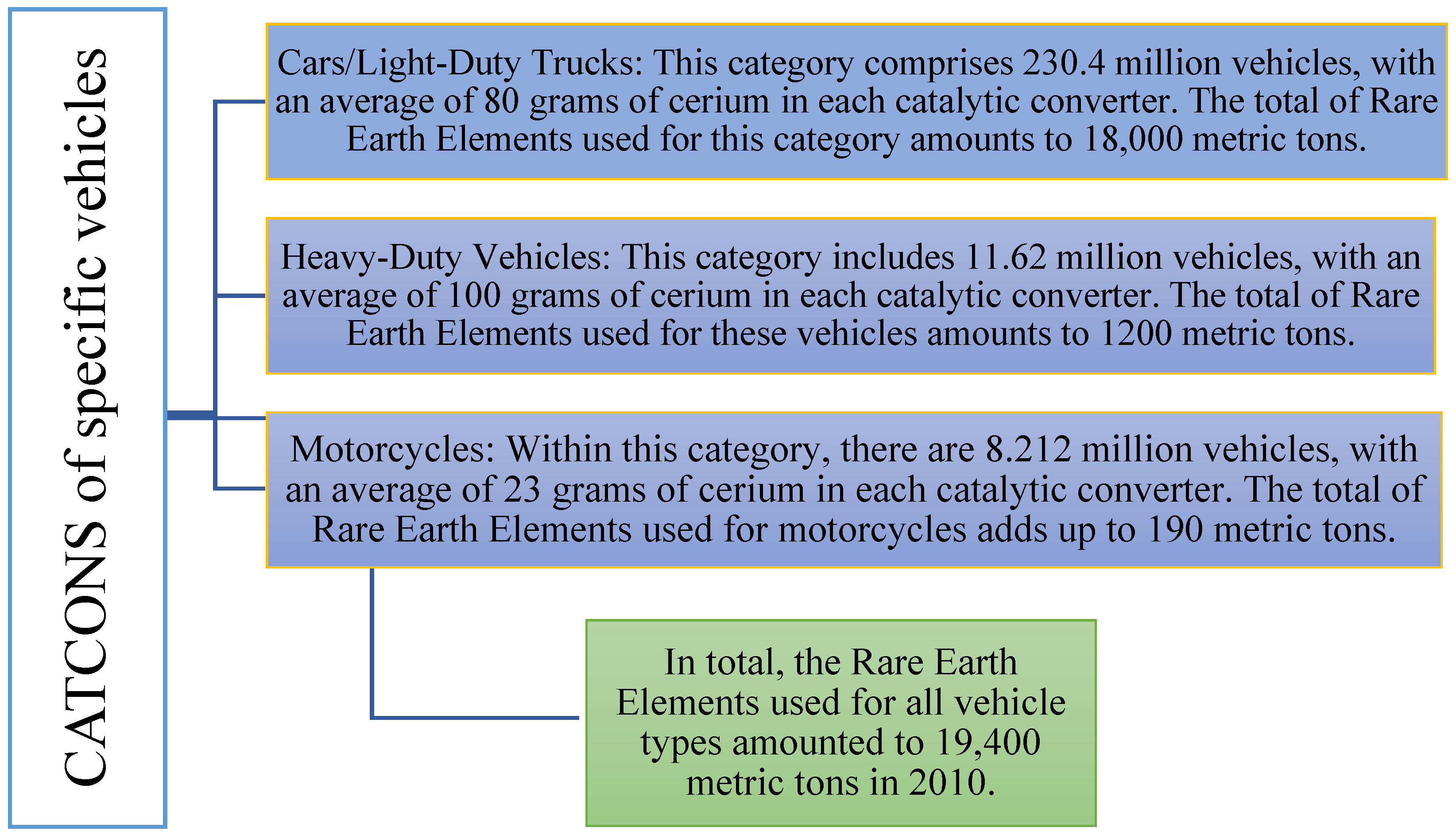
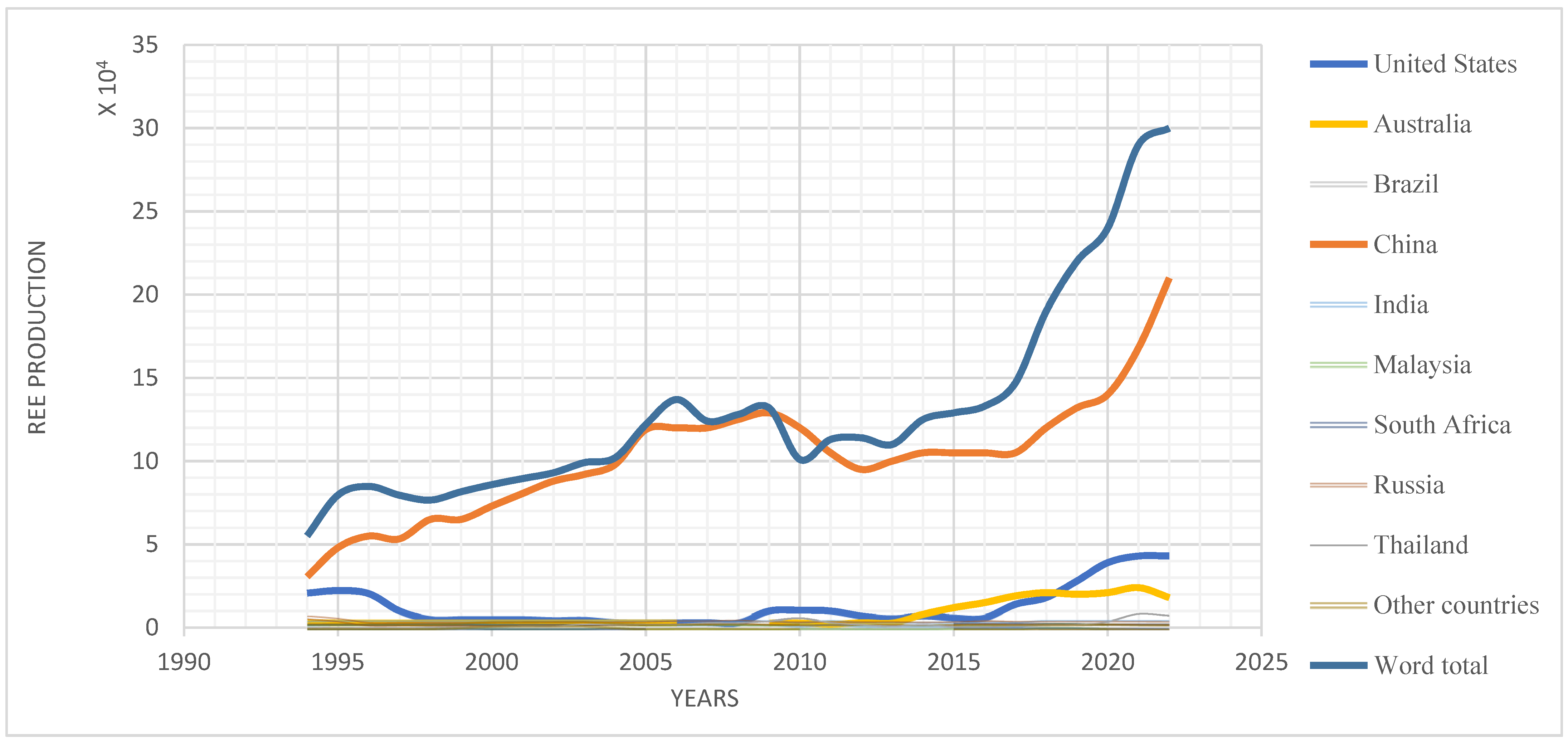
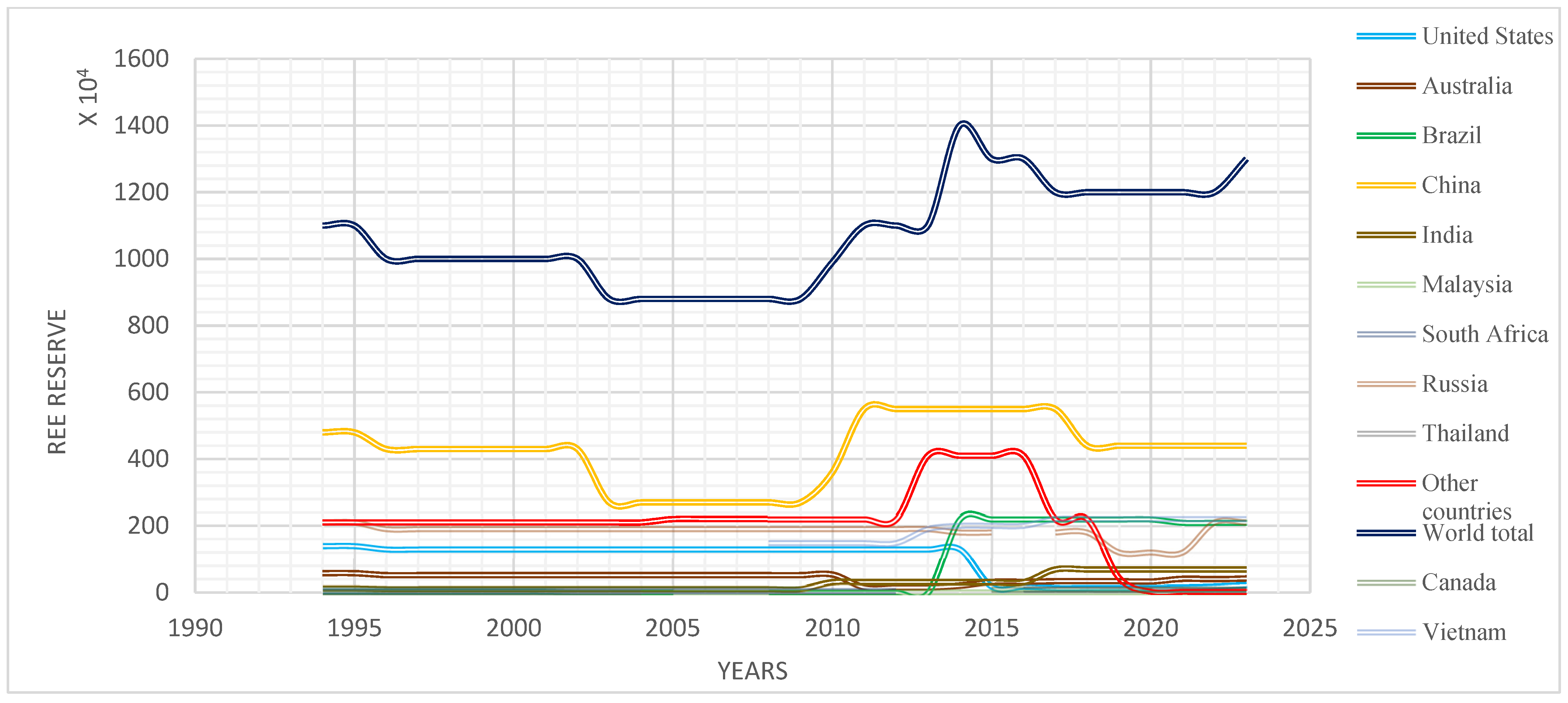

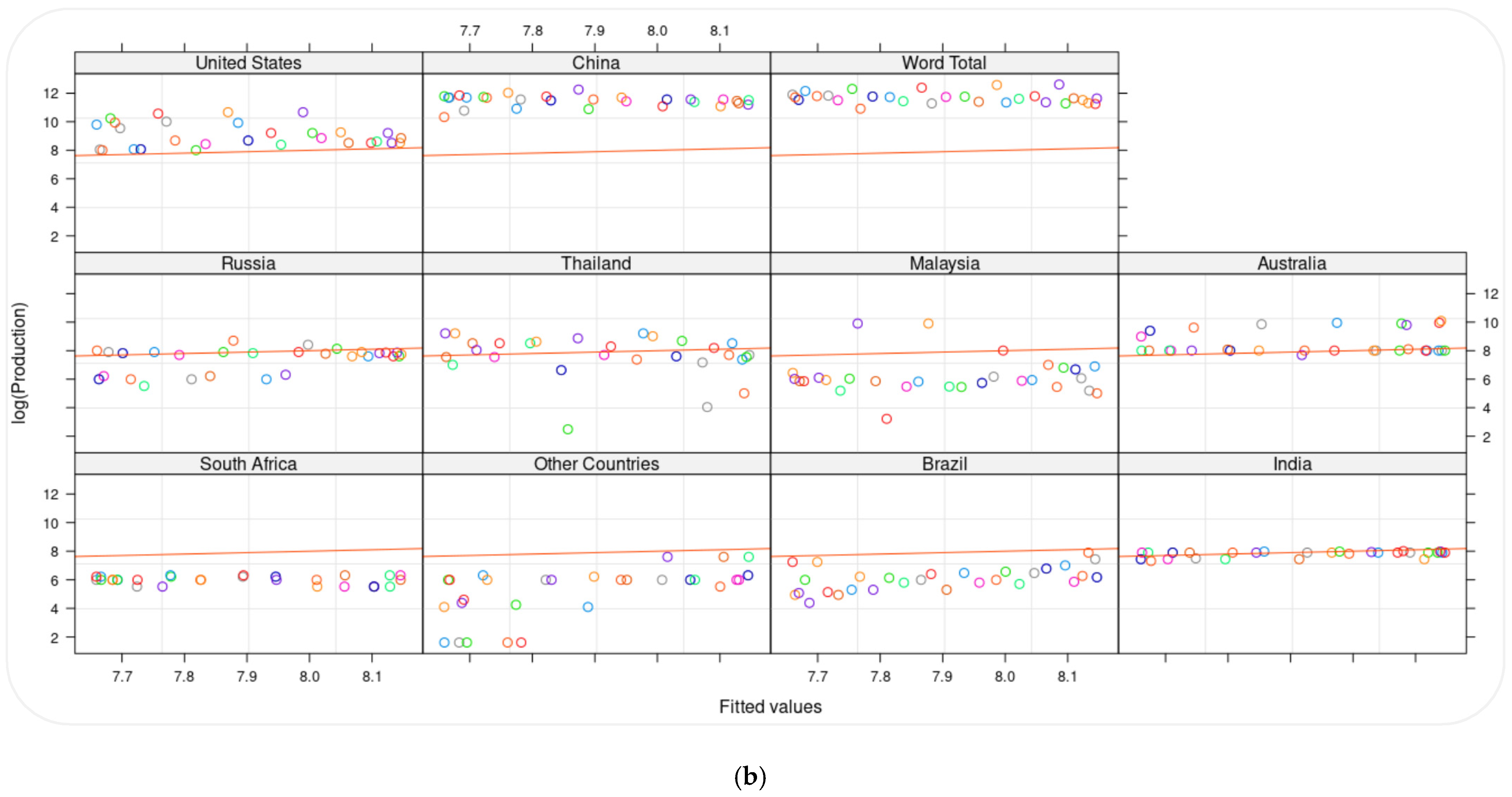

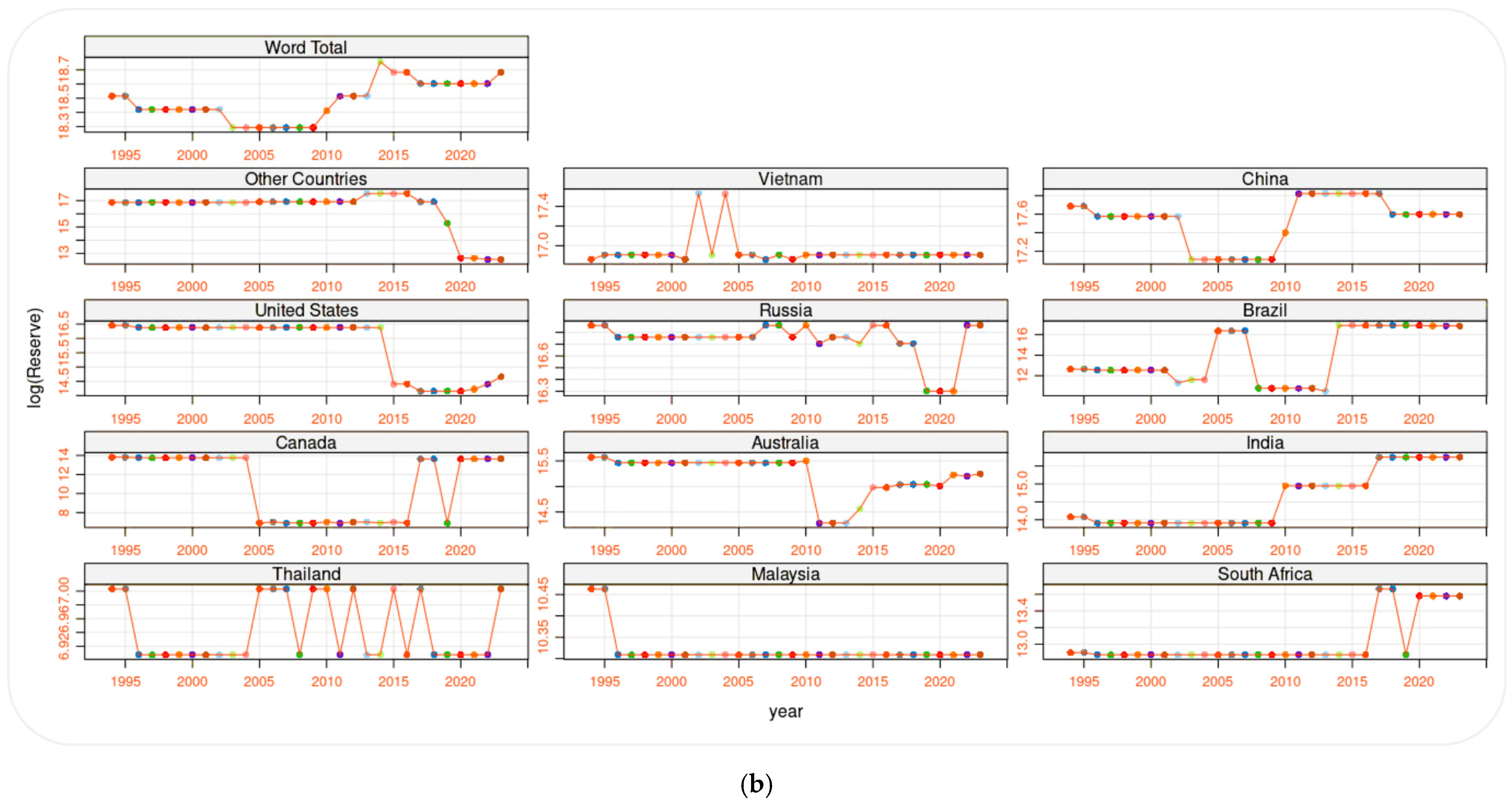
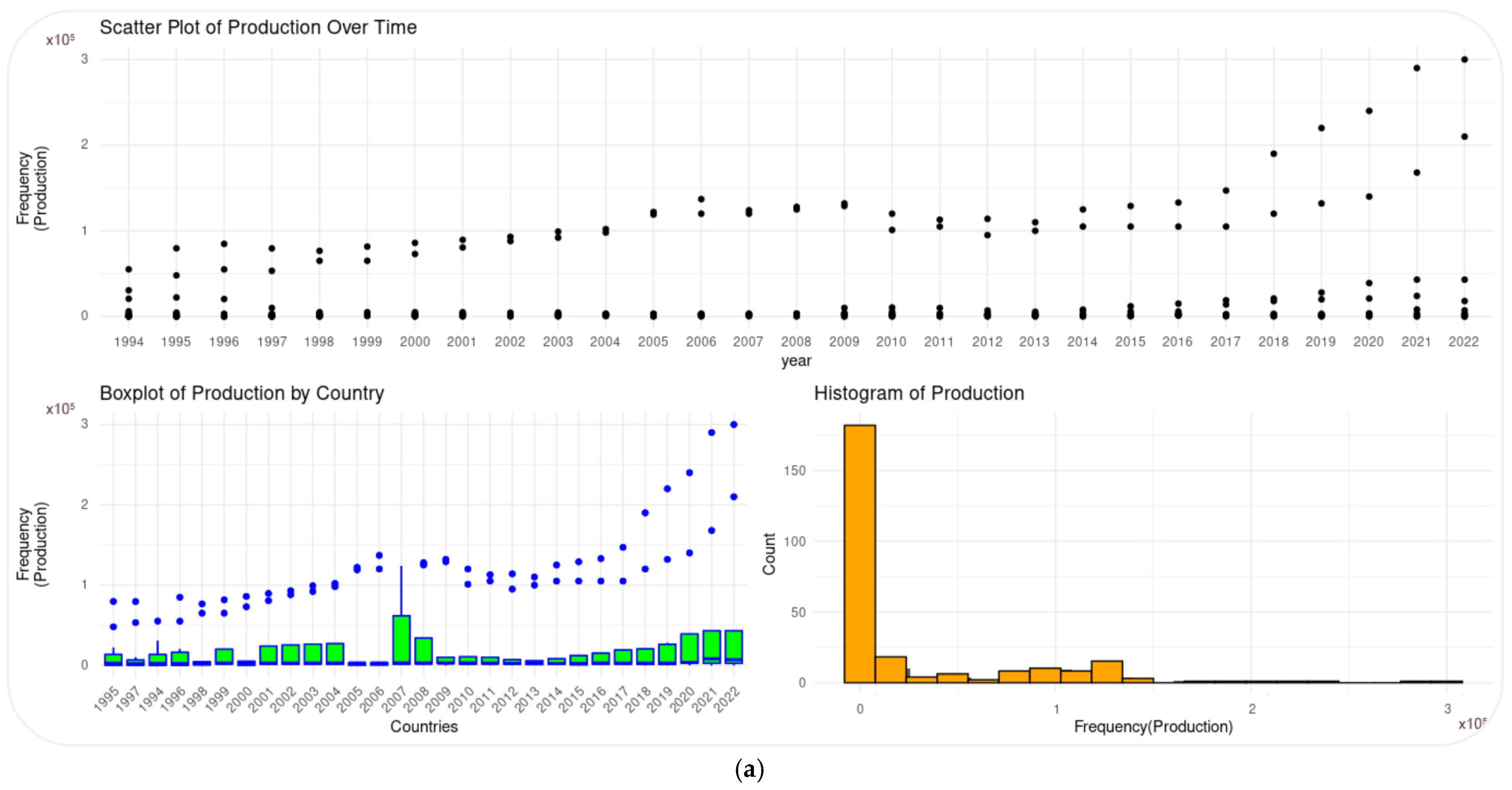

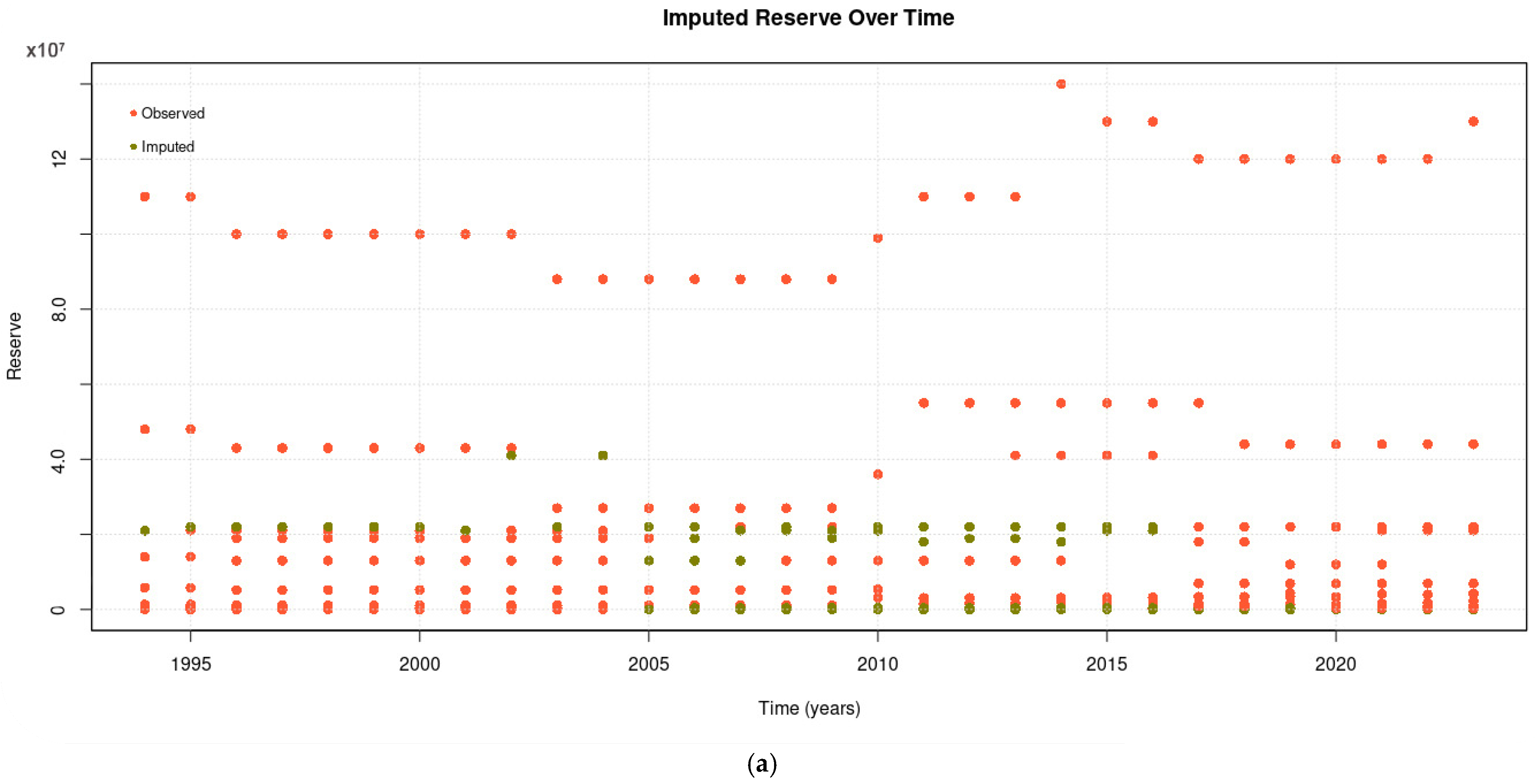

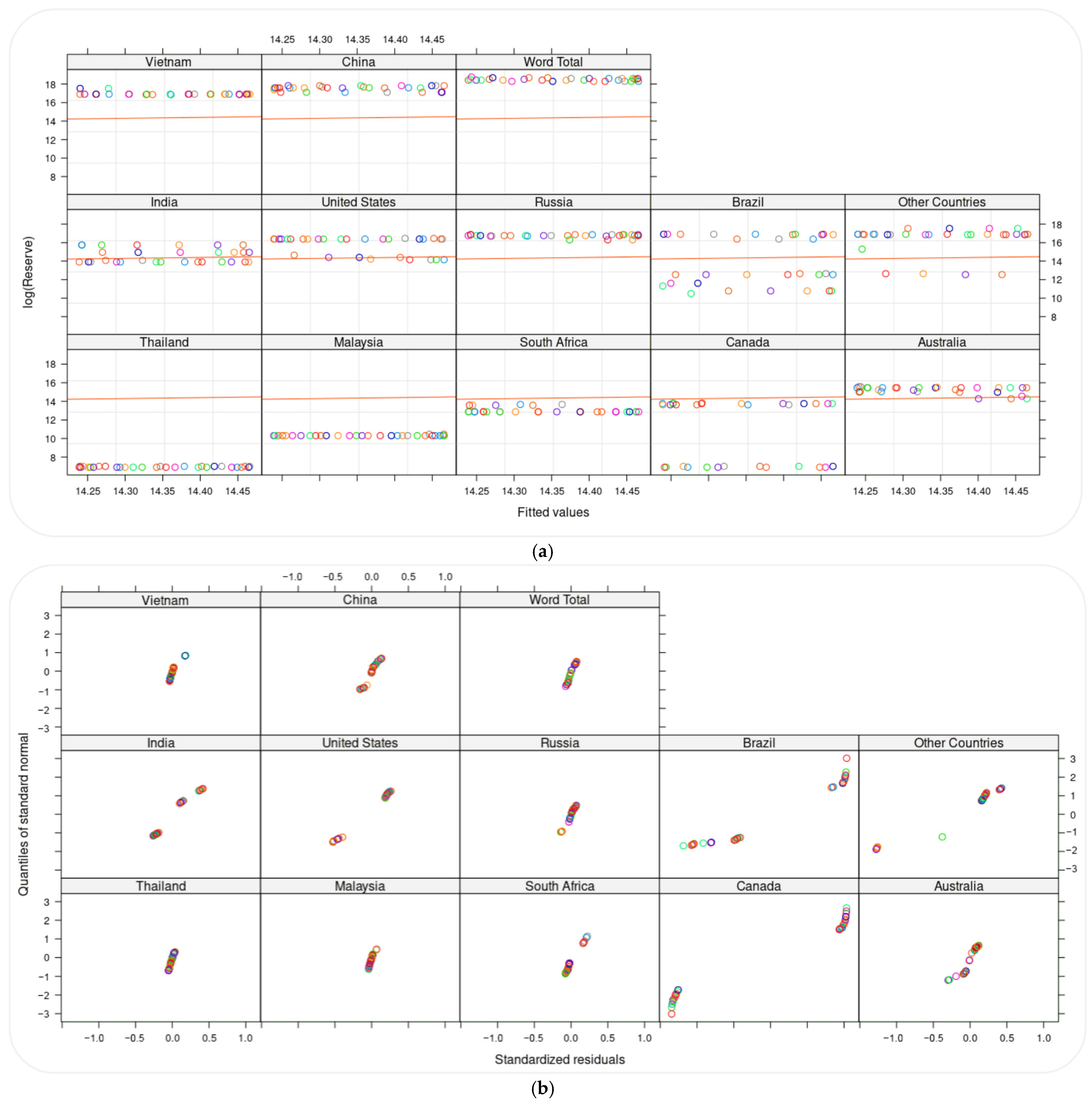



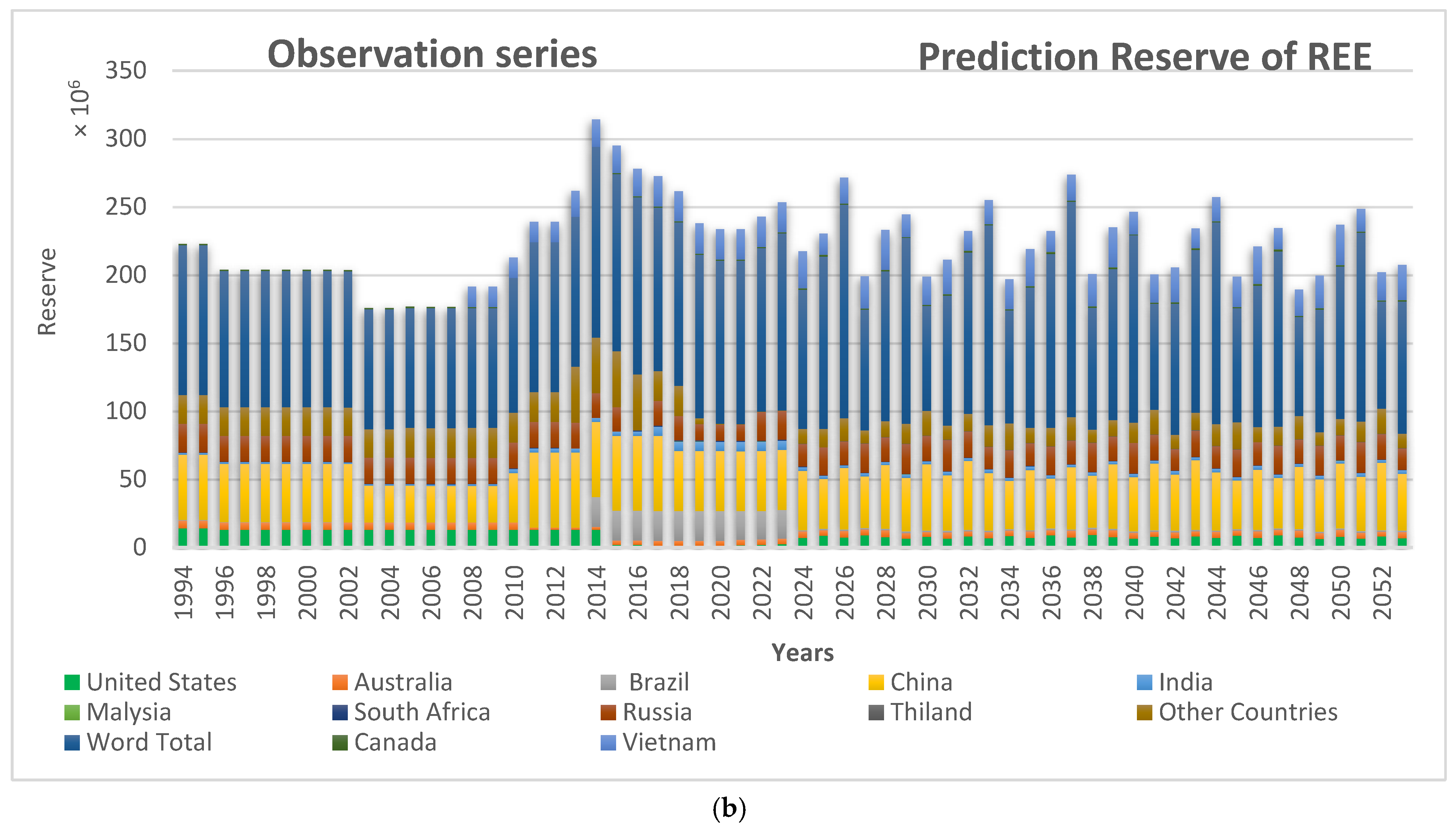
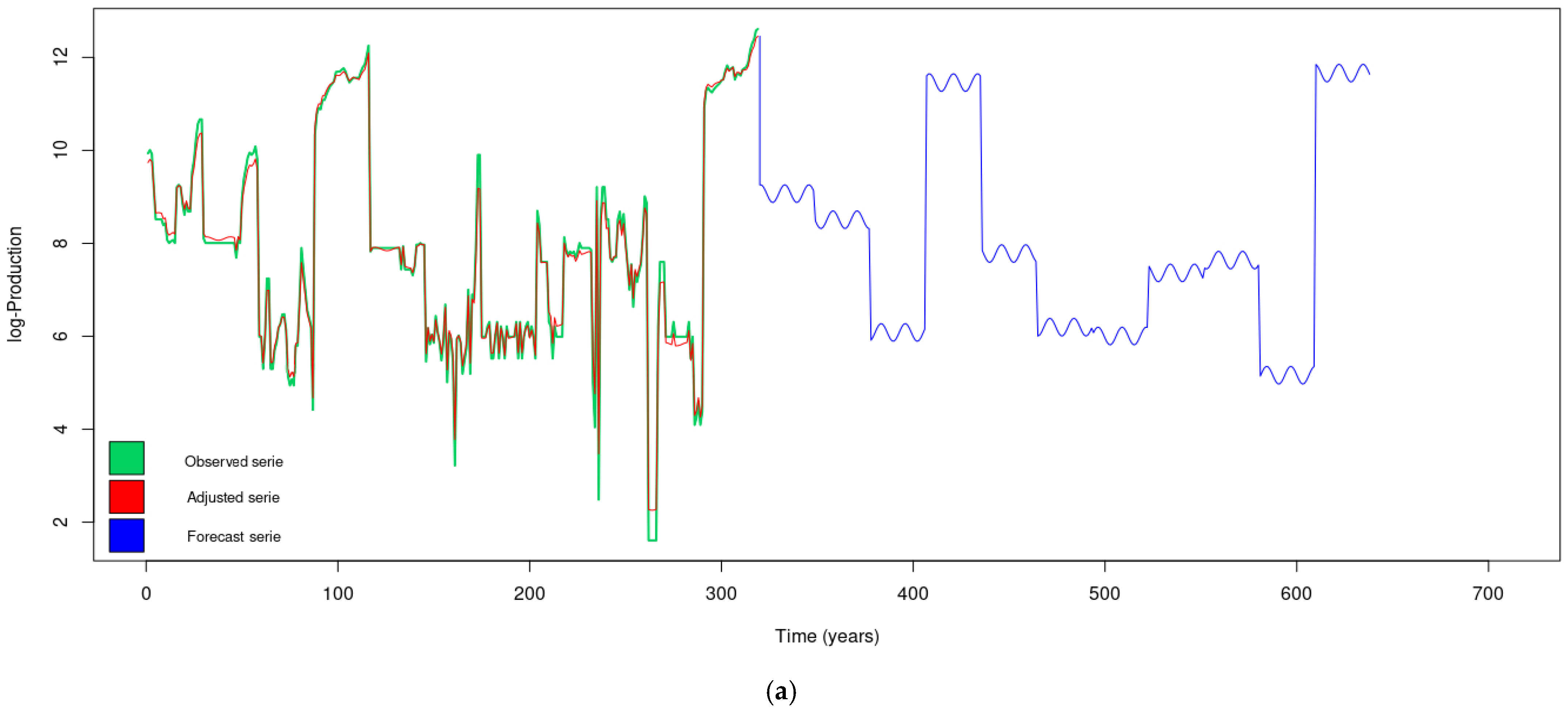

| Battery Electric Vehicles (BEVs) [53] | These are 100% electric vehicles that rely solely on electric power. BEVs use large battery packs to provide a driving range ranging from 160 to 500 km with a single charge. Examples include the Nissan Leaf, with a 62 kWh battery offering a 360 km range. |
| Plug-In Hybrid Electric Vehicles (PHEVs) [54] | PHEVs combine a conventional internal combustion engine with an electric engine that can be charged from an external source. They can significantly reduce fuel consumption by utilizing electricity from the grid. The Mitsubishi Outlander PHEV, with a 12 kWh battery, can drive around 50 km on electric power. |
| Hybrid Electric Vehicles (HEVs) [55,56] | HEVs also combine an internal combustion engine with an electric engine, but they cannot be charged externally. The battery is charged through the vehicle’s combustion engine and regenerative braking. The Toyota Prius, as a hybrid model, offers a 1.3 kWh battery with an electric range of up to 25 km. |
| Fuel Cell Electric Vehicles (FCEVs) [57] | FCEVs use compressed hydrogen and oxygen to power an electric engine, emitting only water as a byproduct. However, most hydrogen is derived from natural gas. The Hyundai Nexo FCEV can travel up to 650 km without refueling. |
| Extended-range EVs (ER-EVs) [58] | Similar to BEVs, ER-EVs have large batteries for electric driving. Additionally, they are equipped with a supplementary combustion engine that charges the batteries when needed. The BMW i3, for instance, offers a 42.2 kWh battery providing a 260 km electric range, with an extra 130 km available in extended-range mode. |
| Countries | Years | Production/Reserve of REEs (t) | Times |
|---|---|---|---|
| United States | 1994 | 20,700 | 1 |
| .. | …….. | .. | |
| 2023 | 43,000 | 29 | |
| China | 1994 | 30,600 | 30 |
| .. | …….. | . | |
| 2023 | 210,000 | 59 | |
| Australia | 1994 | 3300 | 60 |
| .. | .. | ………. | .. |
| Brazil | 1994 | 400 | 100 |
| Other countries | 1994 | 5 | 361 |
| . | ……… | .. | |
| 2023 | 80 | 390 |
| Parameters | Estimation | ||||
|---|---|---|---|---|---|
| Value | Std. Error | DF | t-Value | p-Value | |
| 14.92 | 0.13 | 107.58 | 12.10 | 0.00 | |
| −0.01 | 0.19 | 307.00 | −0.06 | 0.94 |
| Parameters | Estimation | ||||
|---|---|---|---|---|---|
| Value | Std. Error | DF | t-Value | p-Value | |
| 14.919150 | 0.6512213 | 376 | 909494 | 0.000 | |
| −0.106024 | 0.1133042 | 376 | −0.935748 | 0.035 | |
| Random Effect | StdDev | ||||
| 2.330446 | |||||
| 1.432304 | |||||
| σΣ | 0.6433784 |
| Parameters | Estimation | ||||
|---|---|---|---|---|---|
| Value | Std. Error | DF | t-Value | p-Value | |
| 7.902929 | 0.6527760 | 307 | 12.106647 | 0.000 | |
| −0.192340 | 0.0786343 | 307 | −2.446013 | 0.015 | |
| Random Effect | StdDev | ||||
| 2.157274 | |||||
| 0.8848628 | |||||
| σΣ | 0.4324672 |
| Model | df | AIC | BIC | LogLik | Test | L. Ratio | p-Value | |
|---|---|---|---|---|---|---|---|---|
| Rep.gls | 2 | 3 | 1440.6508 | 1451.9275 | −717.3254 | 1 vs. 2 | 484.4494 | <0.0001 |
| Rep.lme | 1 | 5 | 960.2014 | 978.9959 | −475.1007 |
Disclaimer/Publisher’s Note: The statements, opinions and data contained in all publications are solely those of the individual author(s) and contributor(s) and not of MDPI and/or the editor(s). MDPI and/or the editor(s) disclaim responsibility for any injury to people or property resulting from any ideas, methods, instructions or products referred to in the content. |
© 2024 by the authors. Licensee MDPI, Basel, Switzerland. This article is an open access article distributed under the terms and conditions of the Creative Commons Attribution (CC BY) license (https://creativecommons.org/licenses/by/4.0/).
Share and Cite
El Azhari, H.; Cherif, E.K.; El Halimi, R.; Azzirgue, E.M.; Ou Larbi, Y.; Coren, F.; Salmoun, F. Predicting the Production and Depletion of Rare Earth Elements and Their Influence on Energy Sector Sustainability through the Utilization of Multilevel Linear Prediction Mixed-Effects Models with R Software. Sustainability 2024, 16, 1951. https://doi.org/10.3390/su16051951
El Azhari H, Cherif EK, El Halimi R, Azzirgue EM, Ou Larbi Y, Coren F, Salmoun F. Predicting the Production and Depletion of Rare Earth Elements and Their Influence on Energy Sector Sustainability through the Utilization of Multilevel Linear Prediction Mixed-Effects Models with R Software. Sustainability. 2024; 16(5):1951. https://doi.org/10.3390/su16051951
Chicago/Turabian StyleEl Azhari, Hamza, El Khalil Cherif, Rachid El Halimi, El Mustapha Azzirgue, Yassine Ou Larbi, Franco Coren, and Farida Salmoun. 2024. "Predicting the Production and Depletion of Rare Earth Elements and Their Influence on Energy Sector Sustainability through the Utilization of Multilevel Linear Prediction Mixed-Effects Models with R Software" Sustainability 16, no. 5: 1951. https://doi.org/10.3390/su16051951
APA StyleEl Azhari, H., Cherif, E. K., El Halimi, R., Azzirgue, E. M., Ou Larbi, Y., Coren, F., & Salmoun, F. (2024). Predicting the Production and Depletion of Rare Earth Elements and Their Influence on Energy Sector Sustainability through the Utilization of Multilevel Linear Prediction Mixed-Effects Models with R Software. Sustainability, 16(5), 1951. https://doi.org/10.3390/su16051951








